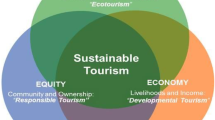Abstract
One of the most famous nomadic herders in the Balkans are the Karakachans. Members of this ethnic group show their affiliation to it surrounded by unrelated ethnic communities in several countries in the Balkans. Today in Bulgaria a majority of the representatives of this ethnic group are living in the region of Sliven. At the beginning of XXI century, the district administration of Sliven still has no clear idea about the potential of the well-preserved authentic culture of the Karakachans. In the regional strategy it has been paid particular attention to the anthropogenic resources for tourism development in the region. Based on the preserved folklore traditions through the centuries, identifying the existing and potential demand for products and services in the field of cultural tourism is put as a task. Unfortunately, the annual gathering of the Karakachans is not mentioned as a possibility for creating a special kind of ethnic tourism, which has many benefits for both members of the community and the area itself. The purpose of this study is to summarize the status and future possibilities of ethnic tourism in Sliven following the example of the Karakachan gathering . The collected empirical material is the result of a field research conducted in the 2012–2013 period. This paper goes beyond a mere description of a particular case and provides new knowledge to academics and practitioners.










Similar content being viewed by others
Notes
See 100th decree of the Council of Ministers of 15 March 1954 laying settling down for life of Karakachans and their residence; http://dediserver.eu/hosting/ethnodoc/data/BG19540315.pdf
Convention for the Safeguarding of the Intangible Cultural Heritage, Paris, 17 October 2003
International cultural tourism charter (Managing Tourism at Places of Heritage Significance, 1999 ), Adopted by ICOMOS at the 12th General Assembly in Mexico, October 1999
References
100th decree of the Council of Ministers of 15 March 1954 laying settling down for life of Karakachans and their residence; http://dediserver.eu/hosting/ethnodoc/data/BG19540315.pdf.
Angelov, J. (2008). Karakachans. Path of black fugitives. The Explorer, (3), 104–111.
Aoyama, Y. (2007). The role of consumption and globalization in a cultural industry: the case of Xamenco. Geoforum, 38, 103–113.
Berghe, P. L. V. D. (1995). Marketing Mayas: ethnic tourism promotion in Mexico. Annals of Tourism Research, 22(3), 568–588.
Chang, J. (2006). Segmenting tourists to aboriginal cultural festivals: an example in the Rukai tribal area, Taiwan. Tourism Management, 27, 1224–1234.
Esu, B., & Arrey, V. (2009). Branding cultural festival as a destination attraction: a case study of calabar carnival festival. International Business Research, 2(3), 182–192.
Getz, D. (2008). Event tourism: definition, evolution, and research. Tourism Management, 29, 403–428.
Ishii, K. (2012). The impact of ethnic tourism on hill tribes in Thailand. Annals of Tourism Research, 39(1), 290–310.
Kalionski, AL. (1999). Karakachans. Ek. Edition of the Agency for Bulgarians Abroad, (6), 37–39.
Karahasan-Chanar, IBR. (2005) Ethnic minorities in Bulgaria, 101–102.
Kosc, Z. (2008). New ethnic holidays in the Sayan-Altai. Photoethnography. Archaeology Ethnology and Anthropology of Eurasia, 36(4), 107–119.
Kumurdjiev, L. (2009) Visiting Karakachans. National geographic, Bulgaria, 9 (47), 106–112.
Lee, C., Lee, Y., & Wicks, B. (2004). Segmentation of festival motivation by nationality and satisfaction. Tourism Management, 25, 61–70.
Lee, I., Arcodia, C., & Lee, T. (2012). Benefits of visiting a multicultural festival: the case of South Korea. Tourism Management, 33, 334–340.
Marinov, V. (1964) Contribution to the study of the origins, life and culture of Karakachans in Bulgaria, Sofia, 12
Nyaupane, G., Morais, D., & Dowler, L. (2006). The role of community involvement and number/type of visitors on tourism impacts: a controlled comparison of Annapurna, Nepal and Northwest Yunnan, China. Tourism Management, 27, 1373–1385.
Official website of the Federation of Cultural and Educational Societies Karakachan in Bulgaria; http://www.karakachani.com/bg/.
Oktyabrskaya, I., Okhotnikov, A., & Chernykh, A. (2008). Holidays in the modern world: traditions and innovations. “Kamva-2007”: traditional culture in the context of the ethno futuristic festival. Archaeology Ethnology and Anthropology of Eurasia, 33(1), 123–133.
Pimpireva, G. (1995) Karakachans in Bulgaria, Sofia.
Pimpireva, G. (1998). Karakachans; communities and identities in Bulgaria, Sofia, 243–244.
Robinson, M. (2001). Tourism encounters: Inter- and intra-cultural conflicts and the world’s largest industry. In N. Al Sayyad (Ed.), Consuming tradition manufacturing heritage: Global norms and urban forms in an age of tourism (p. 43). London: Routledge.
Smith, V. (1989) Hosts and guests: The anthropology of Tourism, University of Pennsylvania Press, p. 4.
Taylor, J. (2001). Authenticity and sincerity in tourism. Annals of Tourism Research, 28(1), 7–26.
Tsenkova, I. (2007). Black. Feature, 28(299), 76–80.
Vatsev, TS. (1996). Karakachans of Berkovica. Historical past and present, M., 5–6.
Walle, A. H. (2011). Marketing equitable ethnic cultural tourism in china. International Journal of China Marketing, 1(2), 57–69.
Wang, H., Yang, Z., Chen, L., Yang, J., & Li, R. (2010). Minority community participation in tourism: a case of Kanas Tuva villages in Xinjiang, China. Tourism Management, 31, 759–764.
Yang, L. (2011). Ethnic tourism and cultural representation. Annals of Tourism Research, 38(2), 561–585.
Yang, L., & Wall, G. (2009). Ethnic tourism: a framework and an application. Tourism Management, 30, 559–570.
Yang, L., Wall, G., & Smith, S. (2006). Ethnic tourism development: Chinese government perspectives. Annals of Tourism Research, 35(3), 753–754.
Yang, J., Ryan, C., Zhang L. (2012). Social conflict in communities impacted by tourism. Tourism Management (30), 1–12.
Zhu, Y. (2012). Performing heritage: rethinking authenticity in tourism. Annals of Tourism Research, 39(3), 1495–1513.
Author information
Authors and Affiliations
Corresponding author
Rights and permissions
About this article
Cite this article
Stoykova, B. Authenticity of ethnic tourism (based on the example of the congregation of the Karakachans in Bulgaria). Int Rev Public Nonprofit Mark 12, 297–313 (2015). https://doi.org/10.1007/s12208-015-0138-3
Received:
Accepted:
Published:
Issue Date:
DOI: https://doi.org/10.1007/s12208-015-0138-3




